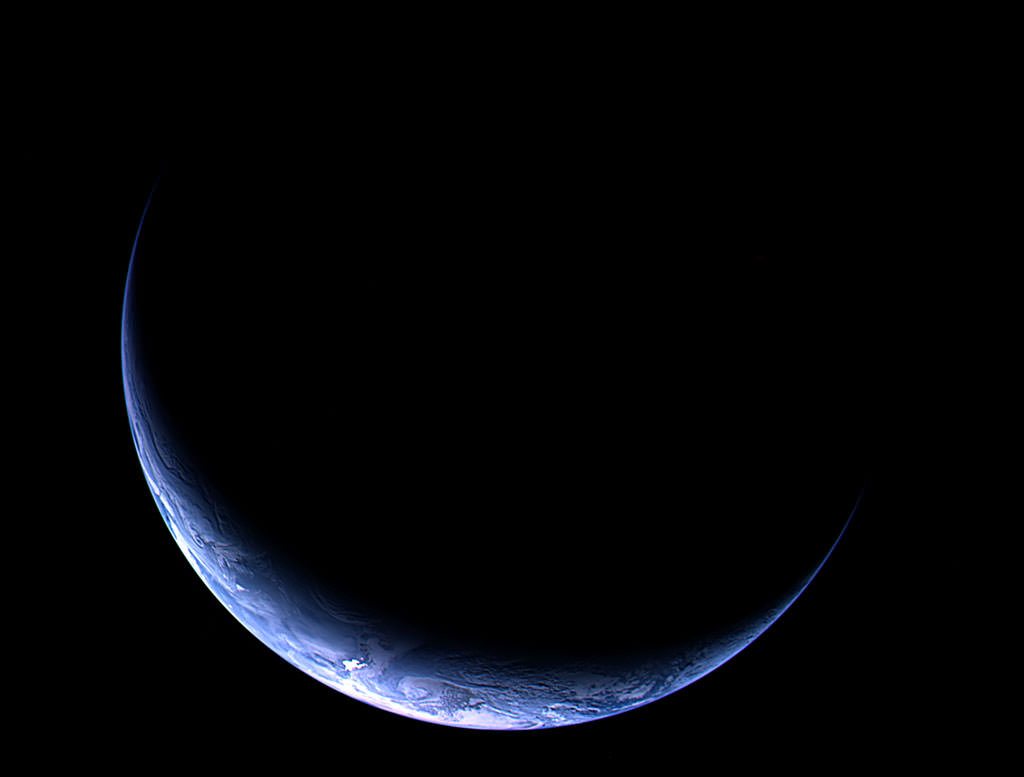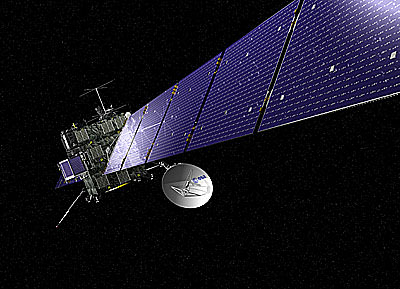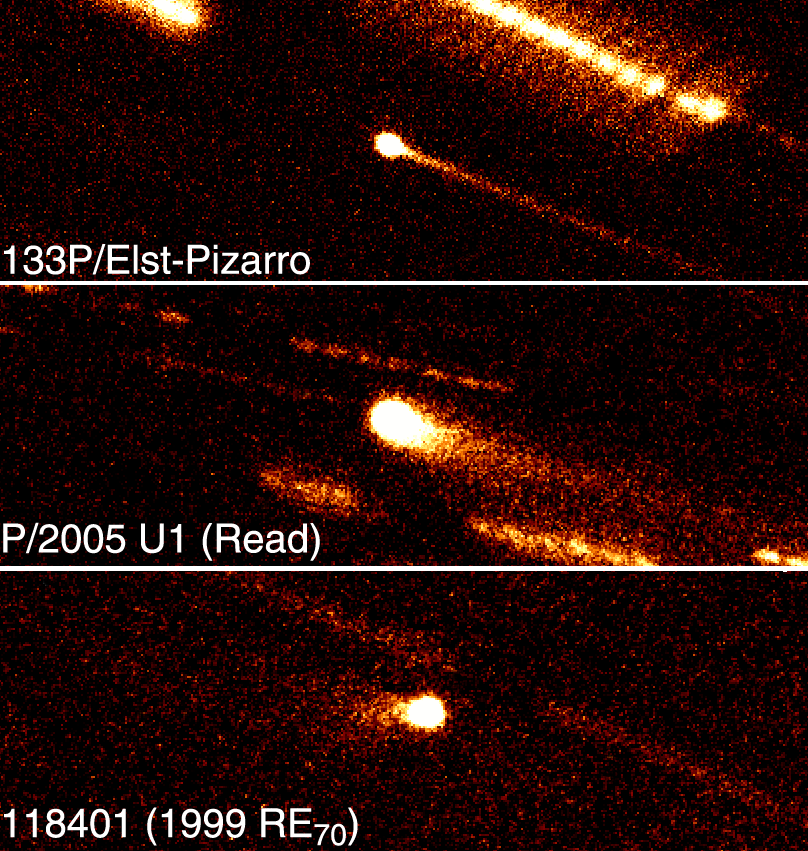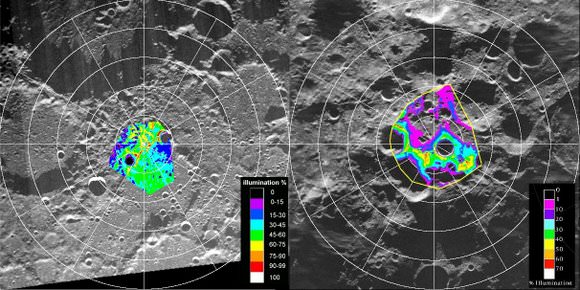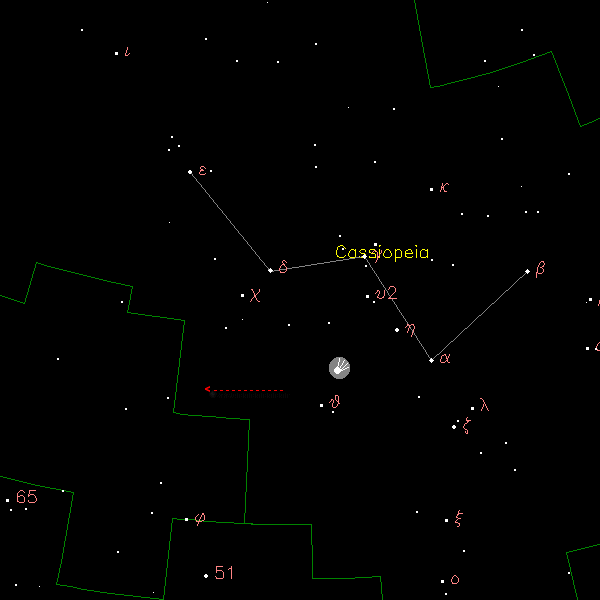Title this one “Rich Blue Crescent” (as opposed to Pale Blue Dot.) This spectacular image of our home planet was captured by the OSIRIS instrument on ESA’s Rosetta comet chaser today (November 12) at 12:28 GMT from about 633,000 km as the spacecraft approached Earth for the third and final swingby. Closest approach is due at 07:45 GMT, on November 13. You can follow Rosetta’s progress at ESA’s Rosetta site and the Rosetta Blog.
Rosetta to Make Final Earth Flyby Nov. 13th
The comet chasing spacecraft Rosetta will make its third and final swing by the Earth on November 13th to pick up more speed for the last part of a 10-year journey that lies ahead. Its mission is to place a lander on comet 67P/Churyumov-Gerasimenko and chase the comet for an entire year on its orbit around the Sun. The spacecraft will be visible to observers from the ground in certain locations on the Earth. This last flyby will increase the spacecraft’s speed by 3.6 km/s (2.2 miles/s) with respect to the Sun, giving Rosetta the energy it needs to boost it to the outer regions of the Solar System.
Rosetta was launched March 2nd, 2004, and will visit a host of targets on its way to comet 67P/Churyumov-Gerasimenko. Rosetta already paid a visit to asteroid 2867 Steins in September 2008. It will visit comet 21 Lutetia 10 June 2010, after which it will go into hibernation until it reaches its final destination in May 2014.
Once Rosetta arrives at 67P/Churyumov-Gerasimenko, it will deploy its Philae lander on the comet’s nucleus, and continue to orbit and study the comet for an entire year during its closest orbit of the Sun. This is the first mission ever to orbit and land on a comet, and promises to return a wealth of data on cometary interaction with the Sun. Comets also contain mostly undisturbed materials from the formation of the Solar System in their nuclei, so studying their composition gives scientists an look into how our Solar System developed.
During the flyby of Earth in November of 2007, Rosetta took the breathtaking image of the Earth pictured here. This next flyby will give observers on the ground a chance to take a look back at Rosetta. The closest approach will occur on November 13th at 8:45 Central European Time (07:45 UT).
Unfortunately, the spacecraft will only be visible from parts of Europe, South America and Africa, as can be seen in the image below. If you are in these regions during the approach, and have favorable conditions, there is a wealth of observing information on the Rosetta blog, specifically on the posts Tips for Sky Junkies I and Tips for Sky Junkies II. They will also be closely following the flyby on the blog, so you can check there for updates on the eve of the event if you are outside the observable range of the spacecraft.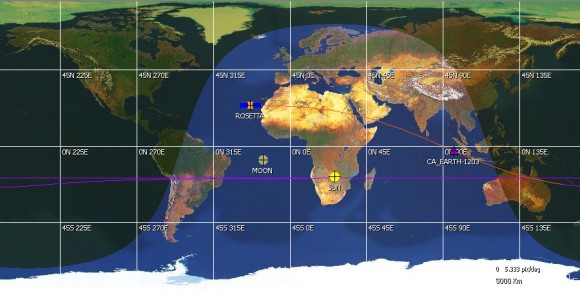
As always, you can check back with us on Universe Today for more coverage of Rosetta’s journey!
Source: ESA
Mini Comets Ejected from Comet Holmes Caused Outburst
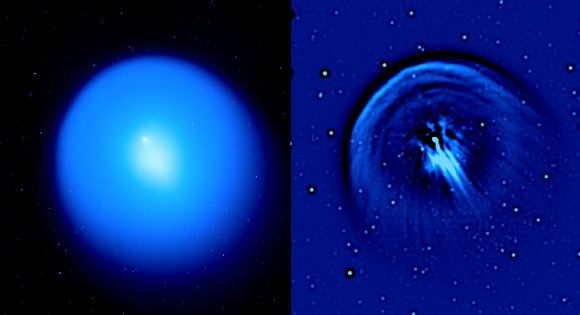
[/caption]
Comet 17P/Holmes caused a sensation in October and November 2007 when overnight, it brightened enough to be visible with the naked eye and became the largest cometary outburst ever witnessed. Using a special filter on the Canada- France- Hawaii Telescope in Hawaii, astronomers were able to peer inside Comet Holmes to determine why the comet became so bright. Images and animations show multiple fragments were ejected and rapidly flew away from the nucleus of comet Holmes.
Astronomers Rachel Stevenson, Jan Kleyna and David Jewitt began observing comet Holmes in October 2007 soon after it was reported that the small (3.6 km wide) body had brightened by a million times in less than a day. They continued observing for several weeks after the outburst and watched as the dust cloud ejected by the comet grew to be larger than the Sun.
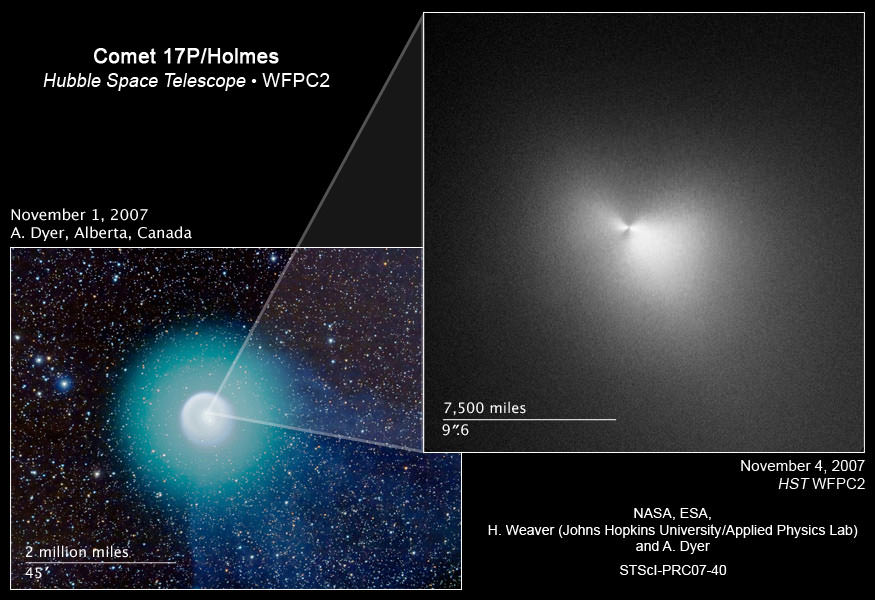
The astronomers examined a sequence of images taken over nine nights in November 2007 using a Laplacian filter which enhances sharp discontinuities within images. It is particularly good at picking out faint small-scale features that would otherwise remain undetected against the bright background of the expanding comet. They found numerous small objects that moved radially away from the nucleus at speeds up to 125 meters per second (280 mph). These objects were too bright to simply be bare rocks, but instead were more like mini-comets creating their own dust clouds as the ice sublimated from their surfaces.
“Initially we thought this comet was unique simply because of the scale of the outburst,” said Stevenson. “But we soon realized that the aftermath of the outburst showed unusual features, such as these fast-moving fragments, that have not been detected around other comets.”
While cometary outbursts are common, their causes are unknown. One possibility is that internal pressure built up as the comet moved closer to the Sun and sub-surface ices evaporated. The pressure eventually became too great and part of the surface broke away, releasing a huge cloud of dust and gas, as well as larger fragments.
Surprisingly, the solid nucleus of comet Holmes survived the outburst and continued on its orbit, seemingly unperturbed. Holmes takes approximately 6 years to circle the Sun, and travels between the inner edge of the asteroid belt to beyond Jupiter. The comet is now moving away from the Sun but will return to its closest approach to the Sun in 2014, when astronomers will examine it for signs of further outbursts.
The team presented their findings at the European Planetary Science Congress in Potsdam, Germany.
Lead image caption: (Left) Image of comet Holmes from the 3.6-meter Canada-France-Hawaii telescope on Mauna Kea showing the large expanding dust coma. On the left, a ‘raw’ image is shown, in which the brightness reflects the distribution of dust in the coma of the comet (the nucleus is in the bright, point-like region to the upper left of center). On the right is shown the same image after application of the Laplacian spatial filter, to emphasize fine structures. The white/black circular objects are background stars enhanced by the Laplacian filter.
Source: Europlanet
Amino Acid Found in Stardust Comet Sample
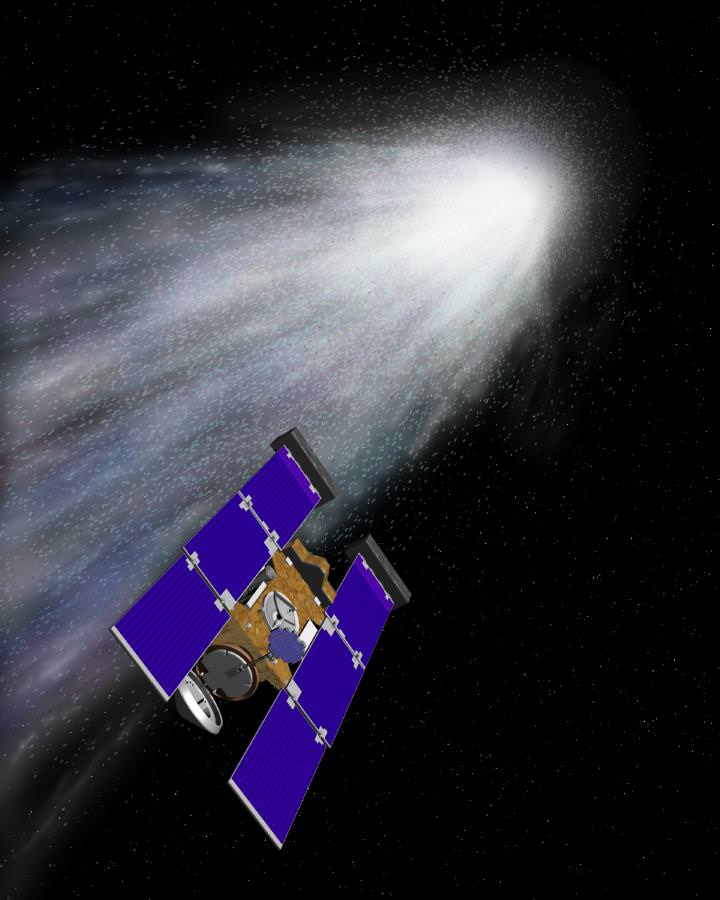
[/caption]
NASA scientists studying the comet samples returned by the Stardust spacecraft have discovered glycine, a fundamental building block of life. Stardust captured the samples from comet Wild 2 in 2004 and returned them to Earth in 2006. “Glycine is an amino acid used by living organisms to make proteins, and this is the first time an amino acid has been found in a comet,” said Dr. Jamie Elsila of NASA’s Goddard Space Flight Center. “Our discovery supports the theory that some of life’s ingredients formed in space and were delivered to Earth long ago by meteorite and comet impacts.”
Proteins are a major component of all living cells, and amino acids are the building blocks of protein. Just as the 26 letters of the alphabet are arranged in limitless combinations to make words, life uses 20 different amino acids in a huge variety of arrangements to build millions of different proteins.
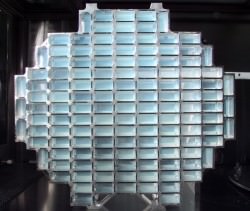
As Stardust passed through dense gas and dust surrounding the icy nucleus of Wild 2 (pronounced “Vilt-2”), special collection grids filled with aerogel – a novel sponge-like material that’s more than 99 percent empty space – gently captured samples of the comet’s gas and dust. The grid was stowed in a capsule which detached from the spacecraft and parachuted to Earth on January 15, 2006. Since then, scientists around the world have been busy analyzing the samples to learn the secrets of comet formation and our solar system’s history.
Earlier, preliminary analysis in the Goddard labs detected glycine in both aluminum foil that lined the collection grids, as well as in a sample of the aerogel. However, since glycine is used by terrestrial life, at first the team was unable to rule out contamination from sources on Earth. “It was possible that the glycine we found originated from handling or manufacture of the Stardust spacecraft itself. We spent two years testing and developing our equipment to make it accurate and sensitive enough to analyze such incredibly tiny samples,” said Elsila. The new research used isotopic analysis of the foil to rule out that possibility.
Isotopes are versions of an element with different weights or masses; for example, the most common carbon atom, Carbon 12, has six protons and six neutrons in its center (nucleus). However, the Carbon 13 isotope is heavier because it has an extra neutron in its nucleus. A glycine molecule from space will tend to have more of the heavier Carbon 13 atoms in it than glycine that’s from Earth. That is what the team found. “We discovered that the Stardust-returned glycine has an extraterrestrial carbon isotope signature, indicating that it originated on the comet,” said Elsila.
Another team member Dr. Daniel Glavin said, “Based on the foil and aerogel results it is highly probable that the entire comet-exposed side of the Stardust sample collection grid is coated with glycine that formed in space.”
The team’s research will be published in the journal Meteoritics and Planetary Science.
Source: NASA
Half Comet-Half Asteroid a Fluke? Nope
[/caption]
Back in 1996, astronomers discovered a strange object in the asteroid belt. They decided it was either a “lost” comet or an icy asteroid, as it ejected dust like a comet but had an orbit like an asteroid. No one had ever seen anything like the object, called 133P. Ever since it was found, astronomers have wondered if it was just an oddity — one of a kind. We now know it is not, and the discovery of more of these half asteroids/half comets means there is a new class of objects in our solar system.
One of these new objecst, 176P/LINEAR is also emitting dust as it orbits in the asteroid belt. It was found by Henry Hsieh at Queen’s University, Belfast in Northern Ireland. Hsieh has been working to figure out the unusual behavior of 133P. He hypothesized that either one of two things could explain the existence of the comet-asteroid: “(1.) 133P is a classical comet from the outer solar system that has evolved onto a main-belt orbit, or (2.) 133P is a dynamically ordinary main-belt asteroid on which subsurface ice has recently been exposed,” Hsieh wrote in his paper. “If (1) is correct, the expected rarity of a dynamical transition onto an asteroidal orbit implies that 133P could be alone in the main belt. In contrast, if (2) is correct, other icy main-belt objects should exist and could also exhibit cometary activity.”
Hsieh thought it was unlikely a comet could have been kicked around enough to end up in orbit in the asteroid belt, so he followed the assumption that 133P was a dynamically ordinary, yet icy main-belt asteroid. He set out to prove the hypothesis that 133P-like objects should be common and could be found by an well-designed observational survey.
Hsieh made 657 observations of 599 asteroids in the asteroid belt and found 176P/LINEAR. He also determined the asteroid is partially made of ice, which is being ejected following a collision with another object, thus the comet-like attributes.
Additionally, since there is evidence for past and even present water in main-belt asteroids, Hsieh says statistically there should be around 100 currently active Main Belt Comets (MBCs) as these objects are called, among the kilometer-scale, low-inclination, outer belt asteroid population.
The Technology Review blog offered suggestions for what to name these new objects that are half comet and half asteroid: “Comsteroids? Asteromets? Hsiehroids?”
Hseih’s paper,
Hseih’s website on MBCs
Sources: Technology Review Blog, arXiv
Newly Discovered Cometary Route Sneaks Past Jupiter, but Decreases Risk of Earth Impacts
Astronomers have used the comet record — including 2001 RX14 (Linear) at left, captured in 2002 by the Sloan Digital Sky Survey — to model a new route for incoming comets that sneaks past Jupiter’s gravity.
The pathway might even be the dominant one that delivers Oort Could comets on an Earth-bound trajectory, say the authors of a new study in Science this week — but if that’s true, comets only rarely cause extinctions on Earth.
(Image credit: Mike Solontoi/University of Washington)
Scientists have debated how many mass extinction events in Earth’s history were triggered by a space body crashing into the planet’s surface. Most agree that an asteroid collision 65 million years ago brought an end to the age of dinosaurs, but there is uncertainty about how many other extinctions might have resulted from asteroid or comet collisions with Earth.
In fact, astronomers know the inner solar system has been protected at least to some degree by Saturn and Jupiter, whose gravitational fields can eject comets into interstellar space or sometimes send them crashing into the giant planets. That point was reinforced last week (July 20) when a huge scar appeared on Jupiter’s surface, likely evidence of a comet impact.
There are about 3,200 known long-period comets, which can take anywhere from 200 to tens of millions of years to orbit the Sun. Among the best-remembered is Hale-Bopp, which was easily visible to the naked eye for much of 1996 and 1997 and was one of the brightest comets of the 20th century.
It has been believed that nearly all long-period comets that move inside Jupiter to Earth-crossing trajectories originated in the outer Oort Cloud, a remnant of the nebula from which the solar system formed 4.5 billion years ago. It begins about 93 billion miles from the sun (1,000 times Earth’s distance from the sun) and stretches to about three light years away (a light year is about 5.9 trillion miles). The Oort Cloud could contain billions of comets, most so small and distant as to never be observed.
The orbits of long-period comets can change when they are nudged by the gravity of a neighboring star as it passes close to the solar system, and it was thought such encounters only affect very distant outer Oort Cloud bodies.
It also was believed that inner Oort Cloud bodies could reach Earth-crossing orbits only during the rare close passage of a star, which would cause a comet shower. But it turns out that even without a star encounter, long-period comets from the inner Oort Cloud can slip past the protective barrier posed by the presence of Jupiter and Saturn and travel a path that crosses Earth’s orbit.
In the new research, University of Washington astronomers Nathan Kaib and Thomas Quinn used computer models to simulate the evolution of comet clouds in the solar system for 1.2 billion years. They found that even outside the periods of comet showers, the inner Oort Cloud was a major source of long-period comets that eventually cross Earth’s path.
By assuming the inner Oort Cloud as the only source of long-period comets, they were able to estimate the highest possible number of comets in the inner Oort Cloud. The actual number is not known. But by using the maximum number possible, they determined that no more than two or three comets could have struck Earth during what is believed to be the most powerful comet shower of the last 500 million years.
“For the past 25 years, the inner Oort Cloud has been considered a mysterious, unobserved region of the solar system capable of providing bursts of bodies that occasionally wipe out life on Earth,” Quinn said. “We have shown that comets already discovered can actually be used to estimate an upper limit on the number of bodies in this reservoir.”
With three major impacts taking place nearly simultaneously, it had been proposed that the minor extinction event about 40 million years ago resulted from a comet shower. Kaib and Quinn’s research implies that if that relatively minor extinction event was caused by a comet shower, then that was probably the most-intense comet shower since the fossil record began.
“That tells you that the most powerful comet showers caused minor extinctions and other showers should have been less severe, so comet showers are probably not likely causes of mass extinction events,” Kaib said.
He noted that the work assumes the area surrounding the solar system has remained relatively unchanged for the last 500 million years, but it is unclear whether that is really the case. It is clear, though, that Earth has benefited from having Jupiter and Saturn standing guard like giant catchers mitts, deflecting or absorbing comets that might otherwise strike Earth.
“We show that Jupiter and Saturn are not perfect and some of the comets from the inner Oort Cloud are able to leak through. But most don’t,” Kaib said.
Source: Science and Eurekalert. The paper appears online today at the Science Express website.
Sub-surface Oceans In Early Comets Suggest Possible Origin of Life
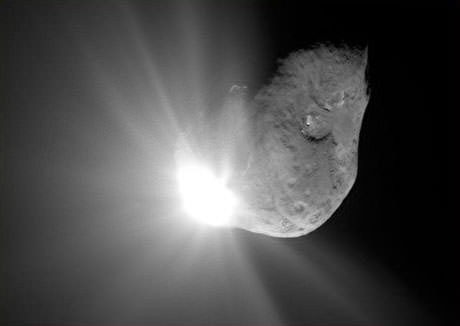
[/caption]
A new study claims early comets contained vast interior oceans of liquid water that may have provided the ideal conditions for early life to form.
In a paper published in the International Journal of Astrobiology, Professor Chandra Wickramasinghe and his colleagues at the Cardiff Centre for Astrobiology suggest the watery environment of early comets, together with the vast quantity of organics already discovered in comets, would have provided ideal conditions for primitive bacteria to grow and multiply during the first 1 million years of a comet’s life.
The Cardiff team has calculated the thermal history of comets after they formed from interstellar and interplanetary dust approximately 4.5 billion years ago. The formation of the solar system itself is thought to have been triggered by shock waves that emanated from the explosion of a nearby supernova. The supernova injected radioactive material such as Aluminium-26 into the primordial solar system and some became incorporated in the comets. Professor Chandra Wickramasinghe together with Drs Janaki Wickramasinghe and Max Wallis claim that the heat emitted from radioactivity warms initially frozen material of comets to produce subsurface oceans that persist in a liquid condition for a million years.
Professor Wickramasinghe said: “These calculations, which are more exhaustive than any done before, leaves little doubt that a large fraction of the 100 billion comets in our solar system did indeed have liquid interiors in the past.
Comets in recent times could also liquefy just below their surfaces as they approach the inner solar system in their orbits. Evidence of recent melting has been discovered in recent pictures of comet Tempel 1 taken by the “Deep Impact” probe in 2005.”
The existence of liquid water in comets gives added support for a possible connection between life on Earth and comets. The theory, known as cometary panspermia, pioneered by Chandra Wickramasinghe and the late Sir Fred Hoyle argues the case that life was introduced to Earth by comets.
Source: University of Cardiff
1908 Tunguska Event Caused by Comet, New Research Reveals
[/caption]
The 1908 Tunguska event has always been mysterious and intriguing because no one has been able to fully explain the explosion that leveled 830 square miles of Siberian forest. But the latest research has concluded that the Tunguska explosion was almost certainly caused by a comet entering the Earth’s atmosphere. And how researcher Michael Kelly from Cornell University came to that conclusion is quite interesting: He analyzed the space shuttle’s exhaust plume and noctilucent clouds.
“It’s almost like putting together a 100-year-old murder mystery,” said Kelley, a professor of Engineering, who led the research team. “The evidence is pretty strong that the Earth was hit by a comet in 1908.” Previous speculation had ranged from comets to meteors.
Noctilucent clouds are brilliant, night-visible clouds made of ice particles and only form at very high altitudes and in extremely cold temperatures. These clouds appeared a day after the Tunguska explosion and also appear following a shuttle mission.
The researchers contend that the massive amount of water vapor spewed into the atmosphere by the 1908 comet’s icy nucleus was caught up in swirling eddies with tremendous energy by a process called two-dimensional turbulence, which explains why the noctilucent clouds formed a day later many thousands of miles away.
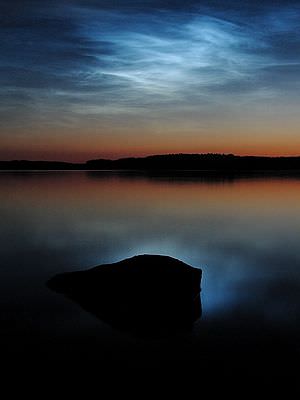
Noctilucent clouds are the Earth’s highest clouds, forming naturally in the mesosphere at about 55 miles over the polar regions during the summer months when the mesosphere is around minus 180 degrees Fahrenheit (minus 117 degrees Celsius).
The space shuttle exhaust plume, the researchers say, resembled the comet’s action. A single space shuttle flight injects 300 metric tons of water vapor into the Earth’s thermosphere, and the water particles have been found to travel to the Arctic and Antarctic regions, where they form the clouds after settling into the mesosphere.
Kelley and collaborators saw the noctilucent cloud phenomenon days after the space shuttle Endeavour (STS-118) launched on Aug. 8, 2007. Similar cloud formations had been observed following launches in 1997 and 2003.
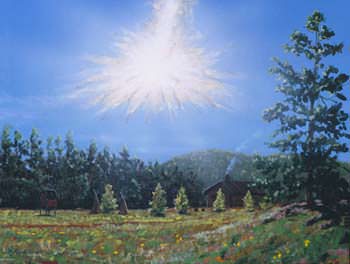
Following the Tunguska Event, the night skies shone brightly for several days across Europe, particularly Great Britain — more than 3,000 miles away. Kelley said he became intrigued by the historical eyewitness accounts of the aftermath, and concluded that the bright skies must have been the result of noctilucent clouds. The comet would have started to break up at about the same altitude as the release of the exhaust plume from the space shuttle following launch. In both cases, water vapor was injected into the atmosphere.
The scientists have attempted to answer how this water vapor traveled so far without scattering and diffusing, as conventional physics would predict.
“There is a mean transport of this material for tens of thousands of kilometers in a very short time, and there is no model that predicts that,” Kelley said. “It’s totally new and unexpected physics.”
This “new” physics, the researchers contend, is tied up in counter-rotating eddies with extreme energy. Once the water vapor got caught up in these eddies, the water traveled very quickly — close to 300 feet per second.
Scientists have long tried to study the wind structure in these upper regions of the atmosphere, which is difficult to do by such traditional means as sounding rockets, balloon launches and satellites, explained Charlie Seyler, Cornell professor of electrical engineering and paper co-author.
“Our observations show that current understanding of the mesosphere-lower thermosphere region is quite poor,” Seyler said. The thermosphere is the layer of the atmosphere above the mesosphere.
Source: NewsWise
Ice on the Moon? NASA, ISRO May Collaborate to Find Out
[/caption]
The debate has endured since the early 1960’s: could there be water ice hiding in deep, dark craters near the Moon’s poles, left untouched by sunlight? Several spacecraft orbiting the moon have tried to peer into these craters to find out, but so far no definitive data has been obtained either way. But now NASA and the Indian Space Research Organization (ISRO) are looking to team up two spacecraft to try and answer the question once and for all. “When it happens, it is going to be a unique experiment and will be the first of its kind,” said Dr. Mylswamy Annadurai, project director for the Chandrayaan-I orbiter.
ISRO’s Chandrayaan-I, already in lunar orbit and NASA’s Lunar Reconnaissance Orbiter (LRO), scheduled to launch later this month would be maneuvered to orbit simultaneously over the lunar poles, and the data from the both spacecrafts’ radar instruments would be shared and exchanged. Details of the collaboration are still being worked out, but officials hope to finalize the plans within a month.
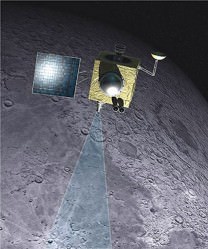
The master plan for the experiment was developed Paul Spudis of the Lunar and Planetary Institute of Houston, who also led the team of US scientists in the Chandrayaan-I project.
“Our experiment should answer first the broad questions about the existence of lunar polar ice, its extent and purity,” Spudis wrote in his paper published in Lunar and Planetary Science journal.
As the first step, on May 19 ISRO scientists shifted Chandrayaan-I to a new orbit 200 km away, lifting it from the 100 km orbit it had been in previously.
“In contrast to some recent claims, this debate is still open and nothing has occurred in the last few years to cause participants in the debate to abandon their positions,” Spudis wrote in an article for the National Space Society in 2006. “No single piece of evidence for lunar ice is decisive, but I think the preponderance of evidence indicates that water ice exists in permanently dark areas near the poles.”
Finding ice in the moon’s polar region would be significant in many respects. The ice could be an abundant water source for future colonists on the moon, as well as being used for producing propellants. However, Spudis said that although polar ice is important, it is not a requirement to successfully live and work on the Moon.
Additionally, any ice on the moon would hold clues to the evolution of the solar system, as the water was likely the product of comets that crashed onto the moon over a billion years ago.
Sources: Bharat Chronicle, NSS
Catching Up With Comet Yi-SWAN
[/caption]
Now that the Moon is out of the early evening sky, far northern observers are out in force hunting down Comet C/2009 Yi-SWAN… and it’s there! In 10X50 binoculars it appears like a very faint, small globular cluster, but definitely has the signature of a comet in a 4.5″ telescope. Surprisingly enough, it’s not very hard to find. Would you like a hand?
First use the rough locator chart that I’ve provided for you at the beginning of this article to get you in the right area. Don’t forget that Cassiopeia is circumpolar and you will need to orient the map according to its position at the time you view it. Rather than confuse you further – just remember as the days pass that Yi-SWAN’s trajectory will take it slowly towards the left hand side of the chart. Here is a close up look at where it will appear in a magnitude 8 filtered field of stars on the night of April 15.

At this point I personally have not observed any tail, nor has any of my co-observers. By using the de-focusing method, we estimate the Comet Yi-SWAN to be right at its 8.5 magnitude mark, totally diffuse and no sign of a bright nucleus at this time. We’d be interested in hearing your observations, too!
Best of luck…

